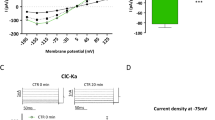Abstract.
Reabsorption of phosphate in the proximal tubule is mainly mediated by the type IIa Na+/Pi cotransporter (NaPi-IIa) and tightly regulated by a variety of factors including dietary phosphate intake and parathyroid hormone (PTH). PTH signals through both apical and basolateral PTH receptors and induces the rapid internalization and subsequent degradation of NaPi-IIa. At least two signalling cascades can be activated by PTH: the PLC/PKC and the cAMP/PKA pathways. Recent evidence from OK cell culture suggested the involvement of MAPK kinases in the PTH action. Here we used freshly isolated coronal mouse kidney slices and incubated them in a physiological buffer in the absence and presence of PTH with inhibitors and activators of the various signalling cascades to further study the events leading to internalization of NaPi-IIa. No alterations in the pattern of immunostaining for α-tubulin, actin and several brush border membrane proteins demonstrated intactness of the slices over the experimental period. Application of PTH (100 nM) induced a strong decrease of NaPi-IIa brush border staining and internalization after 45 min of incubation. The localization of the Na+/sulphate cotransporter (NaSi), however, was not affected. The internalization of NaPi-IIa could be completely prevented by the PKC inhibitor chelerythrine (1 µM) or the MAPK-kinase (ERK1/2) inhibitor PD098059 (20 µM). Without PTH both inhibitors alone had no effect. PTH induced phosphorylation of the ERK1/2 MAPK-kinases which was prevented by PD 098059. Separate activation of the cAMP/PKA pathway by 8-Br-cAMP was completely prevented by PD098059 whereas activation of the PLC/PKC pathway by the PKC activator 1,2-dioctanoyl-sn-glycerol (DOG) and the PKG pathway by 8-Br-cGMP induced internalization of NaPi-IIa which could be only partly blocked by PD 098059. Inhibition by SB203580 or activation by anisomycin of the p38 kinase pathway had no influence on NaPi-IIa localization under control conditions or after PTH stimulation. Furthermore, the PTH-induced decrease in NaPi-IIa protein could be reduced by PD 098059. These results suggest that the ERK1/2 MAPK kinase pathway plays a central role in the signalling of PTH leading to specific internalization and subsequent degradation of the type II NaPi-IIa cotransporter in the proximal tubule.
Similar content being viewed by others
Author information
Authors and Affiliations
Additional information
Electronic Publication
Rights and permissions
About this article
Cite this article
Bacic, D., Schulz, N., Biber, J. et al. Involvement of the MAPK-kinase pathway in the PTH-mediated regulation of the proximal tubule type IIa Na+/Pi cotransporter in mouse kidney. Pflugers Arch - Eur J Physiol 446, 52–60 (2003). https://doi.org/10.1007/s00424-002-0969-8
Received:
Revised:
Accepted:
Issue Date:
DOI: https://doi.org/10.1007/s00424-002-0969-8




